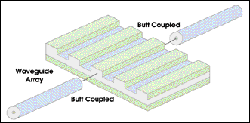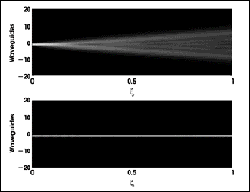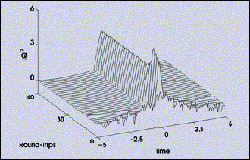
Mode-Locking Technique Well Suited for Fiber Lasers
Breck Hitz
For most of the four decades since their first demonstration, mode-locked lasers have been restricted largely to scientific applications, where skilled technicians can monitor the devices and provide the frequent tweaking necessary for steady operation over extended periods. A major issue with actively mode-locked lasers is the extremely precise synchronization needed between the frequency driving the mode-locking modulator and the resonator round-trip frequency.
Only during the past 10 years have passive techniques, such as the semiconductor saturable absorber mirror, matured to the point where they can reliably mode-lock a commercial laser without an active modulator. Recently, researchers at the University of Washington, Seattle, described a passive mode-locking technique that is especially well suited for fiber lasers.
A mode-locked laser is one in which a short pulse of light bounces back and forth between mirrors, generating an output pulse train as it repeatedly hits the output mirror. A saturable absorber absorbs in light at a given wavelength until the intensity reaches a certain level, and then becomes transparent. Placed inside a resonator, a saturable absorber will mode-lock the laser because all the photons bunch up into a pulse of sufficient intensity to saturate the absorber. Low-intensity light outside the pulse will be lost in the absorber, and all the photons necessary to saturate the laser's gain will congregate in the pulse.

Figure 1. The light from an optical fiber enters a single waveguide in an array, but it can be coupled from that waveguide into the neighboring ones. Images ©OSA.
The Seattle researchers invoked an analogous principle, but they substituted the phenomenon of self-focusing in a waveguide array for the saturable absorber. They showed that when a fiber is coupled to a waveguide array (Figure 1), coupling from the initial waveguide to its neighbors is intensity-dependent (Figure 2). Thus, an appropriately designed waveguide array inside a laser resonator will have the same effect as a saturable absorber: The intracavity photons will bunch up into a pulse of sufficient intensity to pass through the array with minimal loss.

Figure 2. The coupling into neighboring waveguides in an array is dependent on the intensity of the light in the initial waveguide. Low intensity light (top) is strongly coupled into neighboring waveguides, but self-focusing keeps high-intensity light in the initial waveguide (bottom).
Rather than demonstrate their mode-locking technique in the laboratory, the researchers developed a differential equation describing pulse propagation within the resonator, taking into account chromatic dispersion, self-phase modulation, attenuation and the bandwidth of the fiber gain medium. A second equation described the coupling between waveguides in the array. The computational model solved the first equation while periodically applying the second one every round-trip of the resonator.

Figure 3. Computer simulation shows that a stable mode-locked pulse builds up from resonator noise in fewer than 60 round-trips. Each unit on the time scale corresponds to 200 fs, so the mode-locked pulse duration is approximately 200 to 300 fs.
The result was a prediction of stable and robust mode-locking of the laser. For a realistic set of initial conditions, the model predicted that a stable pulse would build up within 60 round-trips (Figure 3).
Published: September 2005